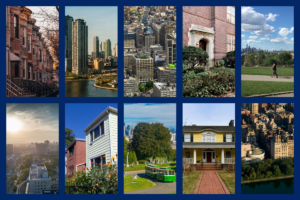For over two years, New Yorkers have watched in curious anticipation as a 467-foot glass pyramid rose over the West Side Highway. The site was once completely forgettable. Just another empty lot that you whiz by on your way out of town. That all changed as soon as ground broke for this remarkable new residential tower. With each incremental stage of construction, it became more and more apparent that this building was going to be cool – completely innovative and a completely new lease on life for this far flung and forgotten outpost of Midtown.
Via 57 West, as the tower is called, is now complete and it is cooler and more eye-catching than we all expected. Designed by the renowned Danish architect Bjarke Ingels, the 750-unit luxury rental building has received tons of praise and accolades, including 2016’s CBTUH Best Tall Building award. Although you can get a sense of how impressive this structure is from the sidewalk, nothing compares to an aerial tour. Check out this video for some truly awesome footage of Via 57 West.
Construction of Via 57 West
Architects and engineers refer to Via 57 West as a tetrahedron, a more technical term for describing a triangular pyramid. Due to its carved-out core, the building forms a saddle-like structure, which Ingels has also referred to as a hyperbolic paraboloid. The 709-unit luxury tower is the newest addition to the residential superblock along West 57th Street developed by the Durst Organization.
Just off the Hudson River and the West Side Highway, the design endeavors to provide an oasis amid the chaos of Midtown. It is the first project designed and completed by Ingels and his firm Bjarke Ingels Group (BIG). Upcoming projects in the United States include a new masterplan for the Smithsonian Institution in Washington, D.C., the new headquarters for Google in Mountain View, CA and Two World Trade Center in Downtown Manhattan.
Design of Via 57 West
According to BIG, Via 57 West was envisioned as “a hybrid between the European perimeter block and a traditional Manhattan high-rise. In many European cities, perimeter blocks are used as a method of dealing with high urban densities without crowding everyone and everything into huge high rises. Instead of a straight-up, solid tower, perimeter blocks are built on all sides surrounding a semi-private central space that is usually open to the air. Despite being based on a traditional urban design concept, there is nothing traditional about Via 57.
Unlike most residential towers in New York City, Via 57 offers a sustainable design that conserves both water and energy while maximizing access to air and earth. The core of the building is a courtyard designed by Starr Whitehouse Landscape Architects and Planners. Their plan for the courtyard is modeled off the exact design and proportions of another notable NYC green space you’ve probably heard of, Central Park. This 22,000-square foot courtyard replicates the park in its landscape as well with an open lawn mimicking Sheep’s Meadow that is adjacent to a copse of trees and tall grasses meant to replicate the Ramble.
A luxury building with a mindful design, 142 units were assigned as affordable housing. The interior design of the building also champions sustainable design with many of the materials and appliances chosen for their resiliency and low sustainable design. Many of the materials used throughout the building’s interior were selected for their low environmental impact. The units offer energy efficient appliances, low-power thermostats and motion-sensored LED lighting. There is also on-site rainwater harvesting system to reduce demand for reservoir water.
In addition to energy-saving fixtures and appliances, Via 57 also offers a slew of luxury amenities, including a swimming pool, a gym, basketball court, game room, and outdoor sun terrace among other luxury amenities and services.
Related:










